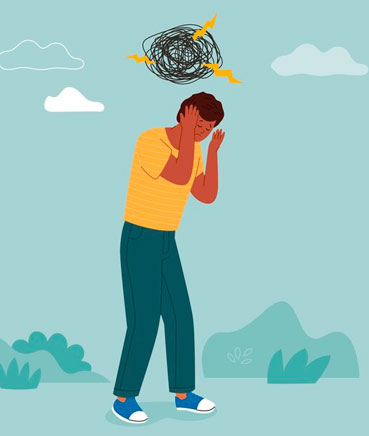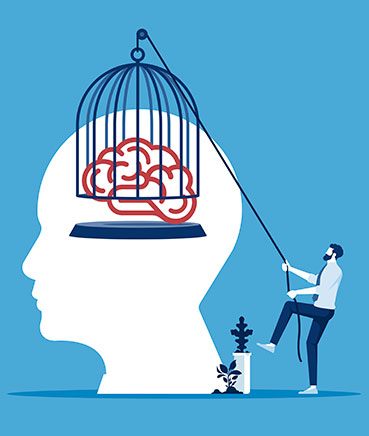In “Getting Caught in a Mind Trap,” Padraic Gibson explores the complexity of obsessive-compulsive disorder and mind traps through a strategic systems approach. The family therapist examines how our perceptions shape our reality and how negative cycles form and persist. It offers valuable insights into creating and escaping these problems, highlighting strategies to transform our mental reality and improve our well-being. A captivating and informative look at the nature of the human mind and methods for overcoming mental difficulties
Reality is not what happens to you; it's what you do with what happens to you.
A. Huxley, The Art of Seeing
The construction of reality
Mental health, resilience, well-being and the pursuit of happiness seem to be within reach of anyone willing to look for a way to get there and there are almost as many suggestions for ways to get there as there are. there are people on earth at this point. In this blog, I'm going to explore another way of thinking about common and even less common problems that humans face. According to a constructivist perspective , our own "unique reality" changes depending on the point of view from which we perceive it. Every view we see changes depending on how we look at it. More importantly, we can have very different reactions to the same events, based on the different meanings we give to things, and no two people have "exactly" the same view of reality.
How to successfully create a problem!
It seems common sense to believe that there is a direct link between how a problem was formed and how it persists. Although this seems obvious to us, it is not a trivial point. This belief is the consequence of a long-standing linear scientific approach, which has been replaced in the natural sciences but unfortunately not in psychology. By following Isaac Newton's approach to science, we have come to believe in cause and effect or linear thinking. Adopting this logic, if we want to know how to solve a problem , we need do nothing more than look for the original causes and, in doing so, we could solve the problem once we understand how it started. .
However, if we study most problems that arise in human systems, we find that there is often no logical connection between how a problem forms and how it can be solved. There is, however, a “circular relationship” between the persistence of a problem and the way people try and fail to solve it. As I will show in this blog, if we wish to make change, it is important to focus on the dysfunctional solutions that are being attempted by the person or human system, if we are to overcome or resolve the problems in question. If we manage to block these dysfunctional solutions, we can interrupt the vicious cycle in which the person has become trapped. Once this negative cycle is interrupted, change becomes inevitable. By using a strategic problem-solving mindset, we can adopt “seemingly” simple logic to solve problems and free the person from their difficulties. By using effective ploys, behavioral distractions, and helpful mental deceptions, people can free themselves from even the most complex human difficulties.

Book an in-office consultation in Paris Montorgueuil or remotely by videoconference
We receive our patients from Monday to Friday.
To make an appointment you can call us on +33 (0) 1 48 07 40 40
or +33 (0) 6 03 24 81 65 or even make it directly online
by clicking here:
A day without end
In the film A Day Without End , journalist and weatherman Phil Connors leaves for the annual report in the village of Punxsutawney where they celebrate Groundhog Day. There he finds himself trapped in time and every morning he wakes up on Groundhog Day. Mental trap or distorted reality? Humans, much like most animals, cannot reinvent and rediscover the world every day. So we tend to apply and reapply strategies that have worked well in the past and we seek to apply them to the problems we currently face. If the solution fails, we tend to do one of two things: we either do more of the same, or we do the complete opposite, leaving things unchanged. These failed attempts at solutions, when reapplied with more people and in more and more different places, end up becoming more rigid and trapping the person in their problem. When we get to this stage, our reactions to the problem have become spontaneous and no longer require any mental effort to trigger them. This has become the way things are.
How to escape from the mental trap?
The way humans react to reality, which generates some of the most common disorders we treat, is not only a phenomenon of everyday life, but it can also (and often does) happen to professionals who cling to their solutions even when they show little effect for patients. It can be far too difficult for professionals to abandon or change ideas or theories even if they are not effective for their patients. What professor of psychology or psychotherapy wants to admit that the strategies he has fought for and researched so diligently turn out to be incorrect or ineffective? When human beings create a stable vision of the world, they tend to bring their experience of the world closer and closer to the perception we want to have of it. We essentially adapt reality to our belief about it.
Mental trap and systemic approach
The systemic and strategic approach is very effective in the treatment of OCD . Obsessive and compulsive disorders are part of the psychopathologies studied in the third year of the LACT course and in the Clinical Master of Giorgio Nardone (CTS) .
Related Resources and Articles
- GENERAL - Stress, anxiety and anxiety disorders - By Claude de SCORRAILLE
- CASE STUDY - Stress, anxiety and anxiety disorders - Valéria, a very weakened warrior - By Olivier BROSSEAU
- Anxiety disorders: In the beginning, how to identify anxiety disorders?
- Anxiety disorders: Can we see both avoidance and control strategies in a patient?
- Anxiety disorders: Is paranoia part of the category of psychosis?
- Anxiety disorders: Does the anxiety disorder make it easier to stay in the exhaustion of the stress mechanism?
- Anxiety disorders: Faced with pathological doubt, how can you help a person?
- Anxiety disorders: the interval of therapeutic sessions from the first session
- Eco-anxiety: From learning impermanence to taking action
- Containment, deconfinement and paradoxes. Included video. Claude de Scorraille
- COVID 19 - from fear to emotional distress, reducing the risk of post-traumatic stress disorder - Claude de Scorraille
- Overcome fear and anxiety through hypnosis and self-hypnosis. Michele Ritterman.





